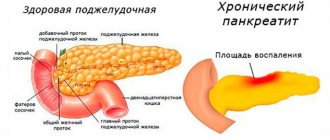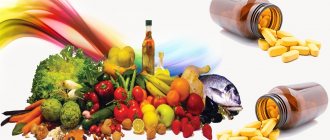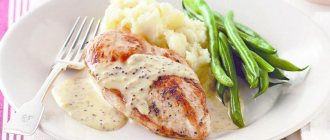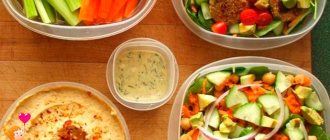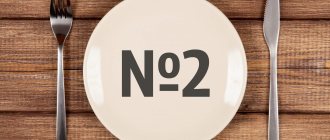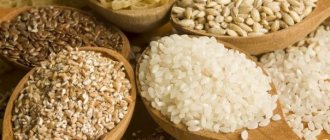Colitis is an inflammatory disease of the colon. Treatment of colitis is always complex. A prerequisite for successful treatment is adherence to a diet.
If you have
chronic colitis
, you should
undergo regular preventive treatment
.
General rules. Duration of the diet.
Nutrition for colitis should be balanced in nutrients. The main goal of the diet is to reduce the load on the entire digestive tract.
- General rules of nutrition for intestinal colitis:
- Fractional meals. 5-6 times a day.
- Give preference to pureed and semi-liquid foods.
- Food should not be hot or cold. The optimal food temperature is 30-40 C
- Elimination of foods containing fiber
- Reduce salt intake to 8-10 grams per day
- Maintain a drinking regime (at least 1.5 liters per day)
- Food can be boiled or steamed.
“Hand in hand” with dysbiosis
There are two forms of colitis - acute and chronic . In both the first and second cases, the infectious component plays a special role in the occurrence and development of the disease - most often bacterial dysentery . It can be triggered by other representatives of pathogenic microflora (for example, coli bacteria, staphylococci, streptococci, bacteria of the Proteus group, etc.). In other words, colitis goes “hand in hand” with dysbacteriosis. Inflammation can also be caused by previous intestinal infections and poor diet, as well as inadequate therapy with various medications. As practice shows, the causes of inflammation are indeed multiple. Let's summarize the main factors :
- infection in the gastrointestinal tract;
- infection with salmonella, staphylococci and other pathogenic microflora due to consumption of poor-quality food;
- the presence of worms (but not in all cases);
- inadequate, monotonous diet (mainly carbohydrates);
- allergies to certain types of food;
- chronic constipation;
- alcohol abuse;
- neglect of personal hygiene rules (for example, touching food with dirty hands);
- long-term use of certain antibiotics that can provoke dysbacteriosis;
- intoxication (poisoning with lead, arsenic and its preparations, mushrooms);
- nervous and emotional tension, stress.
Colitis ulcerosa - all Stages
Nutrition for colitis during exacerbation.
During an exacerbation of colitis, diet is very important. The goal of the diet is to stop inflammation in the intestines, restore proper digestion and eliminate the processes of fermentation and putrefaction.
To do this, it is recommended to completely eliminate foods that cause fermentation or rotting. For diarrhea, it is necessary to exclude foods rich in fiber, vegetables and bran. For constipation, on the contrary, you need to strengthen peristalsis and eat a lot of vegetables and cereals.
Dishes should be steamed or boiled. Food must be ground, chopped or pureed. It is better to overcook the porridge or use special porridge for baby food.
Description of the disease and symptoms
Colitis is an inflammatory process in the large intestine.
The disease can develop due to intestinal infections, poor diet, exposure to radiation, and severe poisoning. Less commonly, pathology is caused by worms, taking antibacterial drugs, and stress. Symptoms depend on the type of disease.
Most often observed:
- increased gas formation, bloating;
- pain that increases with palpation;
- dehydration;
- loss of appetite;
- diarrhea, blood in stool;
- general asthenic condition;
- elevated body temperature.
Nutrition for chronic colitis.
Outside of exacerbation, following a diet for colitis allows you to avoid exacerbation.
The diet is based on porridge boiled in water and semi-liquid food. You can add butter to the porridge. Soups are prepared on the second broth from lean meat. Vegetables can be added in small quantities, pureed.
You can eat eggs in the form of steamed omelettes, fish cutlets or steamed minced beef.
You can drink weak black and green teas, herbal tea. Coffee is not recommended, but can be replaced with chicory. The daily volume of water consumed should be about 1.5 liters.
Page 2 of 12
Diet therapy for varying levels of inflammatory bowel disease
If the disease activity is high (frequent stools with a significant admixture of blood, abdominal pain, fever, joint pain, etc.), it is necessary to limit or completely eliminate regular food and replace it with artificial nutrition. Artificial nutrition is divided into enteral (in which nutritional mixtures enter the body through the mouth or tube) and parenteral (in this case, nutritional mixtures are administered intravenously).
Currently, the following types of enteral mixtures are distinguished: standard, semi-element mixtures, modular, targeted mixtures.
Standard mixtures contain all the necessary macro- and micronutrients in accordance with the daily needs of the body. They are used in most clinical situations when there are indications for enteral nutrition, with the exception of severe disorders of digestion and absorption of nutrients, as well as organ pathology (liver, kidney, etc.). Such mixtures include “Nutricomp standard liquid”, “Nutrizon standard”, “Clinutren optimum”, “Fresubin original” and a number of others.
Semi-element mixtures also include fully balanced nutrients, in which proteins are presented in the form of split molecules (peptides and amino acids). They are prescribed for severe disorders of the digestive and absorption functions, including in the early postoperative period (Peptamen, Nutrien Elemental).
Modular mixtures contain only one of the nutrients (protein, fat) or individual amino acids (glutamine), metabolic regulators (L-carnitine). They are used to supplement the diet of artificial or conventional medical nutrition.
Directional mixtures are created to correct metabolic disorders typical for this pathology (hepatic - Nutricomp Hepa Liquid, renal - Nutricomp Renal, immunity disorders (Impact Enteral, Nutricomp Immune Liquid, Nutrien Immun), diabetes mellitus – “Nutricomp Diabetes Liquid”, “Diazon”).
Methods of introducing enteral mixtures into the body: through a tube (carried out by medical personnel) or through the mouth (by the patient himself). For better absorption of mixtures and prevention of adverse events, it is better to administer the volume of mixture recommended by the doctor in small portions throughout the day. In this case, drip administration of mixtures through a tube can be used for tube feeding. If the patient is able to eat on his own, the “sipping” mode is recommended (drinking through a cocktail straw or in small sips).
Parenteral nutrition can be complete or partial. Total parenteral nutrition is carried out with fully balanced mixtures, including proteins, fats and carbohydrates, as well as vitamins and microelements necessary to maintain the vital functions of the body. Partial parenteral nutrition is provided by the administration of one or two essential nutrients (eg, proteins and carbohydrates).
In the case of intravenous administration of nutritional mixtures, the gastrointestinal tract is excluded from the digestion process. This type of nutrition has both its advantages (lack of irritating effects on the intestines, i.e. sparing it) and disadvantages (long-term shutdown of the gastrointestinal tract). The importance of the latter can be reduced if the duration of intravenous administration does not exceed 7-10 days and even before the end of parenteral nutrition, enteral mixtures are started.
As the activity of inflammation subsides, natural food dishes can be prescribed together with enteral mixtures. Adding dry protein composite mixtures (“DISO” Nutrinor”, “DISO” Nutrifib” and others) to dishes helps to increase the nutritional value of the natural diet (see below)
General characteristics of the diet in the phase of severe exacerbation of the disease. The content of fats and carbohydrates is limited; protein content is normal or slightly increased. A diet with a reduced content of table salt, with a sharp limitation of mechanical and chemical irritants of the mucous membrane of the gastrointestinal tract. Avoid foods and dishes that enhance the processes of fermentation and putrefaction in the intestines; in particular, milk, coarse fiber, spices and all dishes that stimulate bile secretion, gastric and pancreatic secretion. The diet is fractional - 5 - 6 times a day.
Chemical composition and energy value of the diet. Proteins - 70-85 g (of which 40-45 g are animal), fats - 70-80 g (of which 10 g are vegetable), carbohydrates - 250-300 g (of which 50 g are simple). Energy value – 1900-2200 kcal. Table salt – 6 g. Free liquid – 1.5-2 l.
Culinary processing. All dishes are pureed and cooked boiled or steamed. The temperature of hot dishes is 55-600 C, cold - not lower than 150 C.
Recommended products and dishes:
- bread and bakery products - crackers from white wheat bread, not toasted, thinly sliced;
- soups - in vegetarian, low-fat meat or fish broth with the addition of mucous infusions (rice, buckwheat, oatmeal, wheat flour), steamed or boiled meat or fish dumplings, meatballs, egg flakes, boiled and pureed meat, which is added together with mucous decoctions;
- meat and fish dishes - low-fat and lean varieties (beef, veal, poultry) in the form of steam cutlets, dumplings, meatballs, boiled meat soufflé - minced meat is passed 3-4 times through a meat grinder with a fine grid. Only fresh (not frozen) and low-fat varieties of fish (pike perch, bream, carp, cod, navaga, etc.) are allowed. The technology for preparing fish dishes is the same as for meat dishes;
- eggs and egg products - eggs (no more than 1 egg per day) are added to dishes;
- milk and dairy products - fresh cottage cheese (preferably precipitated with calcium salts - calcined) in pureed form. Whole milk – according to tolerance;
- vegetables and herbs are excluded;
- fruits, berries, sweets are excluded;
- cereals and pasta - pureed porridges made from rice, oatmeal, buckwheat, semolina and other cereals are prepared in water or in low-fat meat broth. Legumes are excluded;
- fats - fresh butter is added to dishes;
- snacks - excluded;
— sauces and spices are excluded;
- drinks and juices - weak tea, juices in the form of jelly, fruit and berry jelly, decoction of dried black currants, blueberries, bird cherry.
Prohibited: fresh bread, vegetables, herbs, legumes, fruits, berries in their natural form, mushrooms, whole milk, sauces, spices, snacks, eggs in their natural form, sweets, confectionery, honey, jam, carbonated drinks, cold dishes.
Table 1. Approximate one-day diet menu for severe exacerbation of inflammatory diseases, accompanied by diarrhea
| 1st breakfast: steamed protein omelette, semolina porridge with water, tea |
| 2nd breakfast: calcined cottage cheese (100g) |
| Lunch: pureed meat soup, steamed meatballs, blueberry jelly |
| Afternoon snack: rosehip decoction (1 glass) |
| Dinner: fish soufflé or boiled fish, boiled vermicelli, tea |
| At night: kefir (1 glass) |
| For the whole day: bread (crackers) – 200 g, sugar – 30 g, butter – 10 g. |
This diet option is physiologically inferior and monotonous. That is why, in the phase of severe exacerbation of the disease, it is better to prescribe it only as an addition to standard enteral mixtures in the form of separate dishes for 5-7 days
In the phase of subsiding exacerbation, they switch to a physiologically complete diet with a normal content of proteins and fats, a decrease in carbohydrates with a moderate limitation of table salt, mechanical and chemical irritants of the intestinal mucosa. Avoid foods and dishes that enhance the processes of fermentation and putrefaction in the intestines, as well as active stimulants of gastric secretion. The diet is split - 5-6 times a day.
Culinary processing. Dishes are pureed, cooked boiled or steamed. Soups are pureed or with finely chopped vegetables and well-cooked cereals. Individual dishes can be baked, but without a rough crust. The temperature of hot dishes is 55-600 C, cold - not lower than 150 C.
Chemical composition and energy value. Proteins 70-85 g (of which 45-50 g are animal), fats - 80-100 g (of which 10-15 g are vegetable), carbohydrates - 350-450 g (of which 50-60 g are simple). Energy value – 2400-2900 kcal. Table salt – 6 g.
Recommended products and dishes:
— bread and bakery products — day-old wheat bread, dry biscuit, dry “Maria” type cookies (total bakery products no more than 200 g per day);
- soups - prepared in water, weak low-fat meat or fish broth with well-cooked cereals, noodles, finely chopped vegetables (with the exception of white cabbage);
- meat and fish dishes - from lean meat and fish (non-old and lean beef, veal, chicken, turkey, rabbit, pike perch, pike, navaga cod) cutlets, meatballs, dumplings, soufflés, rolls are prepared in boiled or steamed form form;
- eggs and egg products - soft-boiled eggs (1 piece per day) or as additives to dishes; egg white omelettes, meringues, snowballs;
- milk and dairy products - milk only in limited quantities in dishes, fermented milk drinks - kefir, acidophilus, acidophilus milk, fermented baked milk, yogurt, etc. Freshly prepared cottage cheese (preferably calcined), natural, in the form of curd mass, curd steam puddings;
- vegetables and herbs - zucchini, pumpkin, carrots, green peas and a limited amount of potatoes are cooked boiled and pureed; a steamed vegetable soufflé from pureed vegetables is used. Ripe tomatoes in their natural form - no more than 100-150 g per day;
- fruits, berries, sweets - sweet varieties of berries and fruits (except melons, watermelons, apricots and plums) in the form of pureed compotes, jelly, jellies, mousses and various juices; baked apples, pears, preserves and jams from sweet varieties of berries and fruits; if well tolerated, strawberries, sweet ripe apples and pears can be consumed raw in limited quantities (up to 150 g);
- cereals and pasta - rice, buckwheat, oatmeal, rolled oats, semolina and other cereals in pureed form as side dishes, porridges, casseroles (without crust); vermicelli, noodles, small pasta - in soups, as side dishes and casseroles. It is advisable to add dry composite protein mixtures (for example, “DISO” Nutrinor”) to porridges in the amount of 2 tablespoons in order to increase the protein content in dishes;
- fats - unsalted butter is added to prepared dishes and to the table, but not more than 10 g per meal;
— snacks — mild cheese, Russian, Yaroslavl, etc.; doctor's sausage, pate sausage, veal sausage, soaked herring, jellied meat, jellied tongue;
- sauces and spices - sauces based on weak meat, vegetable and fish broths with dill, parsley leaves, milk bechamel sauce with the addition of a small amount of sour cream, fruit sauces; cinnamon can be used;
- drinks and juices - tea with milk, rosehip infusion, weak black coffee with milk; fruit and berry sweet juices, vegetable juices (not canned) half and half with water.
Prohibited: black bread, baked goods and pastry products; white cabbage, cucumbers, peas, beans, lentils, canned meat, fish, vegetables; fatty meats and fish; fried foods; strong coffee, whole vegetable juices; carbonated and cold drinks; ice cream, whole milk, cream, sour cream in natural form; chocolate and chocolate candies.
Table 2. Approximate one-day diet menu for patients with inflammatory bowel diseases in the phase of subsiding exacerbation
| 1st breakfast: boiled fish, mashed potatoes, pureed rice porridge with the addition of “DISO” Nutrinor mixture, tea |
| 2nd breakfast: calcined cottage cheese (100 g) |
| Lunch: mild grated cheese (30 g), pearl barley soup in meat broth with pureed carrots, meatloaf with pureed buckwheat porridge, apple jelly |
| Afternoon snack: rosehip decoction (1/2 cup), white omelette |
| Dinner: boiled tongue with carrot puree, calcined cottage cheese |
| At night: kefir (1 glass) |
| For the whole day: white bread – 300 g, sugar – 50 g, butter – 10 g, fruits, berries – 300 g |
For inflammatory bowel diseases, during the recovery period, the same diet is prescribed, expanding the diet by eating the same dishes, but not pureed, which allows you to restore the impaired functions of the digestive organs.
General characteristics. The diet is physiologically complete, with a normal content of proteins, fats, carbohydrates and a limitation of table salt, with some limitation of mechanical and chemical irritants of the mucous membrane of the gastrointestinal tract, with the exception of foods and dishes that enhance the processes of fermentation and putrefaction in the intestines, as well as strong stimulants of bile secretion , secretions of the stomach and pancreas, substances that irritate the liver. The diet is split - 5-6 times a day.
Culinary processing. Food is prepared boiled, steamed, and also baked in the oven, and served mostly unchopped. The temperature of hot dishes is 55-60 0 C, cold dishes - not lower than 150 C.
Chemical composition and energy value. Proteins – 75-85 g (including animal 40-50 g), fats – 80-110 g (including vegetable 15-20 g), carbohydrates – 350-450 g (including simple 40-60 g) . Energy value – 2400-2900 kcal. The amount of free liquid is 1.5 l. Table salt – 6 g.
Recommended products and dishes:
- bread and bakery products - day-old wheat bread, dry sponge cake, dry cookies like “Maria” 1-2 times a week, no more than 2-4 buns, well baked, but without adding butter to the dough. Pie with boiled meat and eggs, apples or cheesecake with cottage cheese.
- soups - with water, weak low-fat meat or fish broth with various cereals (except millet), noodles, vegetables (potatoes, carrots, zucchini, pumpkin, cauliflower). If tolerated well, white cabbage, green peas, young beans, and beets are allowed;
- meat and fish dishes - lean and lean meat (beef, rabbit, turkey, chicken), tongue, lean ham, diet sausages, lean fish (pike perch, pike, bream, navaga, cod, carp). Meat and fish, pureed and minced, boiled, stewed, steamed, baked 2 times a week, in pieces;
- eggs and egg products - whole eggs (no more than 1 piece per day) in dishes, protein steamed omelettes, meringues, snowballs. If well tolerated, use whole soft-boiled eggs, steam omelets made from whole eggs;
- milk and dairy products - milk in dishes, if well tolerated, can be consumed in its pure form; fermented milk drinks - kefir, yogurt, acidophilus, acidophilus milk, fermented baked milk, etc. (if well tolerated); fresh, natural cottage cheese, in the form of curd paste, steamed and baked puddings;
- vegetables and greens - potatoes (in limited quantities), carrots, beets, pumpkin, zucchini, cauliflower, boiled, baked, steamed, ungrated and pureed; lettuce and parsley leaves, fresh tomatoes in the form of salad; finely chopped young greens as an addition to dishes. Turnips, cucumbers, radishes, radishes, sorrel, spinach, onions, garlic, mushrooms are excluded;
- fruits, berries, sweets - fresh ripe fruits and berries (except melons, apricots, watermelons and plums), raw, in their natural form, baked; dry fruits and berries; ripe varieties of apples and pears (no more than 200 g per day); if well tolerated - tangerines and oranges; marmalade, pastille, marshmallows, sugar;
- cereals and pasta - various crumbly porridges (except millet and pearl barley) in water, in meat broth, with the addition of milk or a third of 10% cream, steamed and baked puddings, cutlets (without breading), pilaf, zrazy, dumplings, pancakes ; boiled vermicelli, finely chopped pasta, milk noodles in the form of side dishes, casseroles, puddings. During preparation, dry protein composite mixtures (“DISO” Nutrinor”) are added to porridges;
- fats - butter (do not fry) is added to prepared dishes, given in its natural form to the table, no more than 10 g per serving;
— appetizers — jellied fish, tongue, veal, mild cheese, black caviar, doctor’s sausage, soaked herring, lean ham;
— sauces and spices — sauces based on vegetable broth, meat broth using bay leaves, dill, parsley leaves, cinnamon; milk bechamel sauce with the addition of a small amount of sour cream; fruit sauces;
- drinks and juices - rosehip decoction, natural tea with milk or cream, coffee with milk or cream and weak black coffee, fruit juices (except grape), berry juices; vegetable juices (except cabbage), diluted 1/3 with water.
Prohibited: black bread; millet, pearl barley; white cabbage, beans, peas, lentils, mushrooms, fatty meats and fish, fried foods; cucumbers, turnips, radishes, radishes, sorrel, spinach, onions, garlic; fresh melons, apricots, watermelons, plums; grape juice; undiluted vegetable juices; cabbage juice; canned meat, fish, and vegetables; chocolate, cocoa, honey.
If tolerated well, it is allowed to add white cabbage, green peas, young beans, beets to soups; whole milk, young finely chopped greens, tangerines and oranges, marmalade, marshmallows, and marshmallows are introduced into the diet.
Table 3. Sample menu of diet options for patients with inflammatory bowel diseases in remission
| 1st breakfast: rice milk porridge with the addition of “DISO Nutrinor” mixture, steamed protein omelette (from 2 eggs), tea with milk |
| 2nd breakfast: calcined cottage cheese (150 g) |
| Lunch: meat broth soup with cauliflower, boiled meat with boiled rice, fresh apples |
| Afternoon snack: boiled meat, rosehip decoction (200 g) |
| Dinner: baked curd pudding, steamed meatloaf with stewed carrots and green peas, tea with milk, fresh fruits (or berries) |
| At night: kefir (1 glass) |
| For the whole day: white bread – 300 g, sugar – 40 g, butter – 10 g |
If the patient maintains stable remission, significant restrictions on certain products are not required. In addition to boiling, culinary processing also includes baking and even frying. During this period, it is recommended to eat the most natural and fresh foods possible. Despite the ongoing remission, it is advisable to exclude seeds, nuts, mushrooms, vinegar and a number of other foods that are traumatic and irritating to the intestines from the diet.
- Back
- Forward
Types of diets:
In case of exacerbation of chronic colitis or in acute form of colitis with loose stools (diarrhea), diet No. 4 is recommended. This diet does not recommend foods rich in fiber. All dishes that cause rotting and fermentation are also excluded.
If the disease occurs with constipation, then diet No. 3 is recommended. This diet recommends foods that enhance intestinal motility and are rich in fiber.
In case of chronic colitis without exacerbation, it is necessary to adhere to diet No. 2.
Types and forms of colitis
There are several types of pathological process:
- Ulcerative. Accompanied by the appearance of ulcers in the intestines. An increase in body temperature is periodically observed, and constipation occurs. In severe cases, joint pain and blood in the stool are noted.
- Spastic. Most often it develops due to excessive nervous tension. Characterized by increased gas formation, bloating, and abdominal pain.
- Ischemic. Develops with peritonitis, intestinal obstruction. Accompanied by rapid loss of body weight.
- Enterocolitis. The symptoms in most cases resemble food poisoning.
- Pseudomembranous. Accompanied by vomiting and stool disorders. It often becomes chronic.
There are several types of colitis.
There are 2 forms of the disease:
- Spicy. The disease occurs for the first time. Often it is possible to completely cure the patient.
- Chronic. Less responsive to therapy. Characterized by alternating exacerbations and periods of remission. Develops from acute when taking medications is not completed in a timely manner.
Recipes for dietary dishes for colitis.
Sample daily menu from a diet for intestinal colitis:
Breakfast:
Boiled oatmeal with butter. Apple compote.
Lunch:
Steamed beef cutlet. Blueberry jelly.
Dinner:
Rice soup with chicken meatballs. Boiled sea fish. Herb tea
Afternoon snack:
Low-fat cottage cheese casserole. Apple compote.
Dinner:
Meat casserole. Weak tea.
Before bedtime:
Compote or jelly.
Grocery list
If treatment of gastrointestinal diseases using the fourth table according to Pevzner is carried out at home, be sure to have an accurate list of foods allowed and prohibited for this diet.
If some foods and dishes are in doubt, the best option is to consult with your doctor.
Nutritionist comments:
For colitis, therapeutic nutrition is a prerequisite for successful treatment.
A properly selected diet and its adherence can quickly get rid of the unpleasant symptoms of the disease. “The right choice of a sanatorium is a significant step towards maintaining and increasing health. “Gorny” is a resort complex that combines the experience and knowledge of Russian and Soviet balneology. The presence of modern medical equipment and innovative installations, the professionalism of the staff and love for their work will serve as the key to extending longevity,” - the head physician of the sanatorium, Alexander Olegovich Karaulov.
Disease prognosis
The prognosis depends on the stage at which the disease was detected and therapy was prescribed. If a person begins treatment in a timely manner, stable remission can be achieved quickly. Attacks of exacerbations in such situations are stopped quickly, and the opportunity to lead a full life remains.
The doctor draws up a menu for each patient.
If the diagnosis is made late, cancer may develop, and bleeding in the gastrointestinal tract is often observed.
Some patients become disabled. In severe cases, the patient may die.
The development of pathology is influenced by a person’s age, the presence of other diseases, and individual tolerance of the proposed products. The doctor must take these factors into account when creating a menu.
